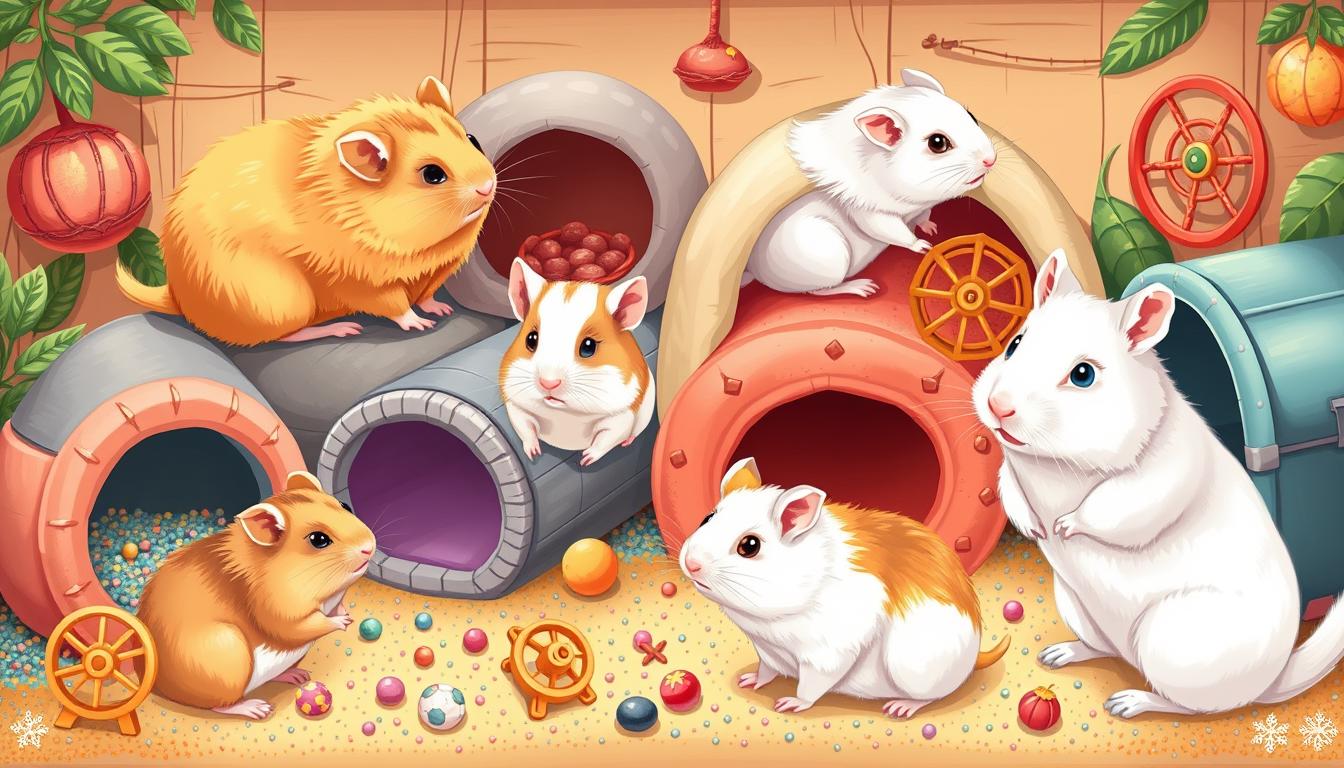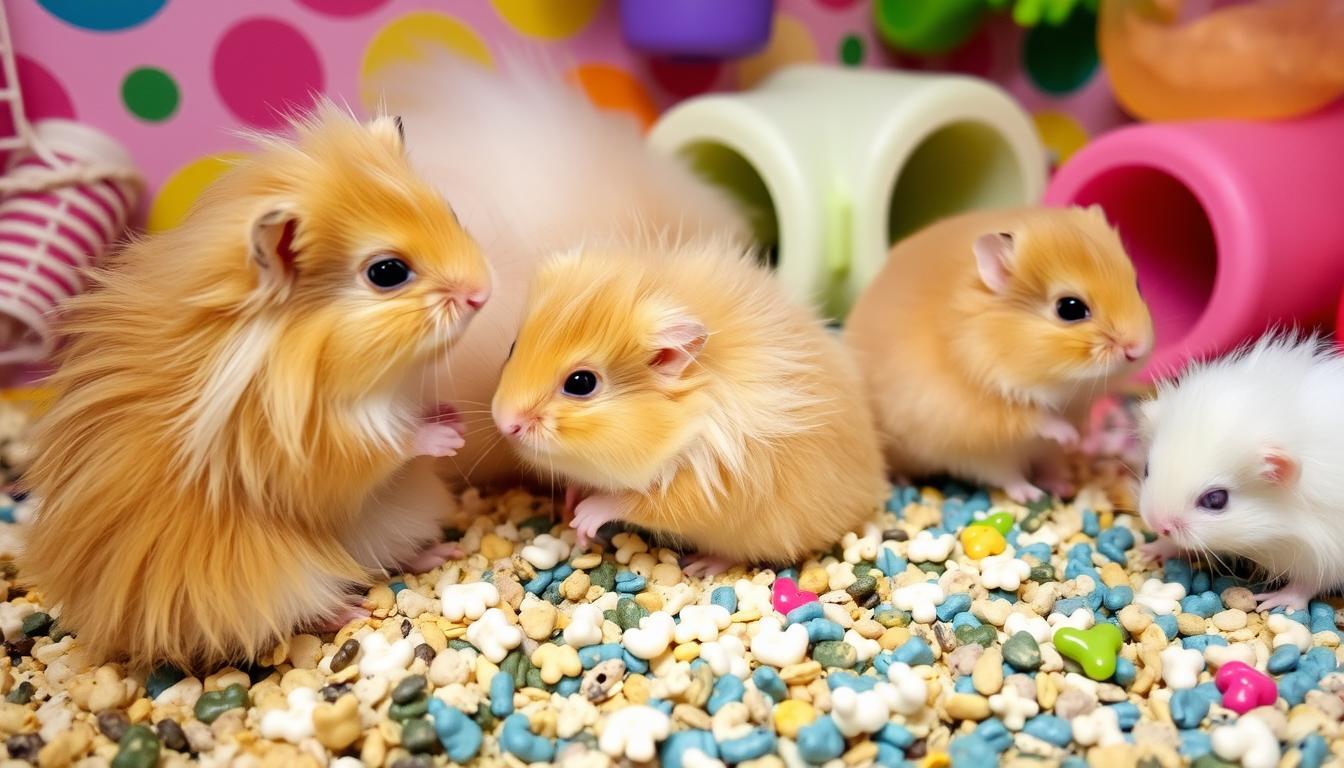Are you thinking about getting a small, furry friend? Hamsters are a great choice, with many breeds to pick from. Each one has its own special traits and needs. This guide will help you understand the different hamster breeds, so you can choose the right one for you.
Key Takeaways
- Explore the captivating world of different hamster breeds, from the classic Syrian to the energetic Roborovski dwarfs.
- Discover the unique traits, care needs, and which pocket-sized companion might be the best fit for your lifestyle.
- Learn from a comprehensive guide that caters to both seasoned hamster owners and those considering adding a new furry friend.
- Familiarize yourself with reputable hamster breeders and ethical breeding practices to ensure a healthy, happy pet.
- Gain valuable insights to make an informed decision about which hamster breed aligns with your preferences and capabilities as a pet owner.
The Captivating World of Hamsters
Hamsters are fascinating and endearing pocket pets that have captured the hearts of animal lovers worldwide. These furry friends come in various breeds, each with its own unique personality and care requirements. In this section, we’ll delve into the world of hamsters, exploring their history, characteristics, and why they make such wonderful companions.
An Introduction to These Adorable Pocket Pets
Hamsters are small, rodent-like creatures that originated in parts of Europe and Asia. They are known for their round, chubby bodies, large cheek pouches, and lively dispositions. These pocket pets have a long history of being kept as household companions, with the Syrian or Golden hamster being the most popular breed.
Why Hamsters Make Great Companions
Hamsters are an excellent choice for pet owners, particularly those with limited space or who are new to pet ownership. Their compact size makes them easy to accommodate, and their playful nature and endearing behaviors make them a delight to observe. Hamsters are also generally low-maintenance, requiring a relatively simple hamster care routine. Additionally, they can be a great educational tool for children, teaching them about animal biology and responsibility.
Whether you’re a seasoned pet owner or looking to welcome your first furry friend, hamsters are sure to captivate and charm you with their unique personalities. In the following sections, we’ll explore the diverse range of hamster breeds and their specific care requirements, empowering you to make an informed decision about which breed might be the perfect fit for your household.
Diving into Different Hamster Breeds
The hamster family is full of different breeds, each with its own special traits and needs. Whether you’re new to hamsters or have had them before, knowing about the various hamster breeds can help you pick the right one. This is important for finding a pet that fits your lifestyle and what you like.
There’s the famous Syrian (or Golden) hamster, the tiny Roborovski dwarf, and the lively Campbell’s dwarf. Each breed has its own look and needs. Let’s explore these amazing pets and see which one might be perfect for you.
Exploring the Diverse Hamster Breeds
- Syrian (or Golden) Hamsters: These are the big, fuzzy friends known for being easy to care for and gentle.
- Roborovski Dwarf Hamsters: These are the smallest hamsters and are very active. They need special care and attention.
- Campbell’s Dwarf Hamsters: These little hamsters are full of energy and curiosity. They love to play and can adapt to different homes.
It’s important to research and find hamster breeders nearby or a hamster breeder near me. This way, you can learn about each breed’s needs and traits. Knowing the differences helps make sure your new pet will be happy and loved in your home.

Remember, every hamster is special, and their personalities and needs can differ, even within the same breed. Be open-minded, do your homework, and find the hamster breed that will bring happiness and friendship into your life.
Syrian Hamsters: The Classic Fuzzy Companions
The Syrian, or Golden, hamster is the most loved and well-known hamster breed. They are known for their cute looks and friendly nature. We will look at their physical traits, personality, and what they need to stay healthy and happy at home.
Appearance and Temperament
Syrian hamsters have round bodies and soft, golden fur. They have a white belly and big cheeks for storing food. They can grow up to 7 inches long, making them the biggest hamster breed.
These hamsters are gentle and love people, which makes them great pets for families and beginners. With the right care, they can become very tame and enjoy being around people.
Care Requirements for Syrian Hamsters
It’s important to give your Syrian hamster the right home and care. They need a big cage, at least 24 inches by 12 inches, with lots of bedding to burrow in. A good diet of hamster food, fruits, and veggies will keep them healthy.
Keeping their cage clean and providing fresh water is also key. This helps prevent health problems. Syrian hamster breeders can offer great advice on syrian hamster care.

“Syrian hamsters are the quintessential furry companions, capturing the hearts of pet owners with their adorable appearance and affectionate personalities.”
If you love hamsters or want to get a Syrian hamster, knowing their needs is crucial. It helps create a loving and fun home for these cute pets.
Roborovski Dwarf Hamsters: Tiny but Mighty
Get ready to fall in love with the Roborovski dwarf hamster, the smallest hamster breed. These tiny creatures are full of energy and curiosity. They come from Central Asia’s deserts and can survive in tough conditions.
Despite being small, roborovski dwarf hamsters are quite strong and active. They can run up to six miles at night. This makes them fun and lively pets for hamster lovers.
Roborovski dwarf hamsters love to be around others. They do well in pairs or small groups. This makes them great for dwarf hamster breeders who want happy, social pets.
“Roborovski dwarf hamsters are the epitome of ‘good things come in small packages.’ Their boundless energy and curious personalities make them truly captivating pets.”
To care for roborovski dwarf hamsters, you need a special home. It should be big, well-ventilated, and have lots of toys and hiding spots. A good diet, including hamster food, veggies, and treats, keeps them healthy.
Whether you’re new to hamsters or an experienced breeder, Roborovski dwarfs will win your heart. Their energy, charm, and toughness make them wonderful pets.
Campbell’s Dwarf Hamsters: The Energetic Explorers
Campbell’s dwarf hamsters are lively and fun to watch. They are small but full of energy and curiosity. This makes them a favorite among hamster lovers.
Characteristics and Behavior
Campbell’s dwarf hamsters are tiny, growing to 4 to 5 inches long and weighing 1 to 2 ounces. Despite their size, they are very active and agile. They love to move around, explore, and play, which makes them adorable.
These hamsters are friendly and gentle, but a bit more sensitive than Syrian hamsters. With the right care and handling, they can become very tame and loving.
Setting Up the Perfect Habitat
It’s important to create a great home for Campbell’s dwarf hamsters. They need a big cage, at least 24 inches by 12 inches, with lots of bedding for burrowing. Adding hides, tunnels, and climbing spots will keep them happy and active.
When breeding, it’s key to remember that Campbell’s dwarf hamsters are best kept alone. This prevents fights. Their home should also have fresh water, the right food, and nesting materials.
| Characteristic | Description |
|---|---|
| Size | 4 to 5 inches in length, 1 to 2 ounces in weight |
| Temperament | Generally friendly and gentle, but can be more sensitive than Syrian hamsters |
| Habitat Requirements | Spacious enclosure (minimum 24 inches by 12 inches), plenty of bedding, hides, tunnels, and climbing objects |
| Socialization | Should be housed individually to prevent aggression and fighting |
Knowing what Campbell’s dwarf hamsters need helps you give them a happy home. They can be wonderful pets for your family.
Conclusion
In this guide, you’ve discovered the world of hamster breeds. You’ve learned about their unique traits and care needs. This guide helps you choose the right hamster for your lifestyle.
Whether you like the Syrian hamster or the Roborovski dwarf, you now know what to look for. This knowledge lets you make a smart choice and welcome a new furry friend.
It’s important to choose responsible and ethical hamster breeding. Look for reputable hamster breeders in your area. This ensures your pet gets the best care.
With the right care, your hamster will be happy and bring joy to your life.
Starting your hamster journey is exciting. Remember to focus on hamster care and research hamster breeds well. Find local hamster breeders or reputable hamster breeders for the best choice.
You and your hamster will make memories and share a lifelong friendship.




